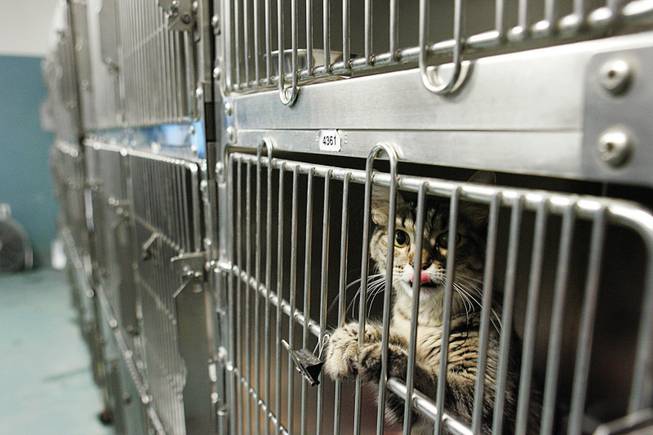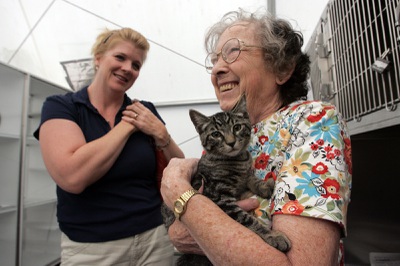
A cat designated “feral” looks out of a cage at the Lied Animal Shelter in Las Vegas on Tuesday. Lied euthanized 11,065 cats in the first seven months of this year.
Published Wednesday, Aug. 13, 2008 | 2 a.m.
Updated Wednesday, Aug. 13, 2008 | 10:24 a.m.
Reader poll

Chris Giunchigliani

Nan Harrison, left, looks on as her friend Louise Gagliardi decides on a cat to adopt at the Lied Animal Shelter on Tuesday. The shelter euthanized more than 11,000 cats in the first seven months of 2008, out of more than 14,000 taken in. Fully domesticated cats like the one Gagliardi chose are more adoptable.
Related Documents
Because the yowling ranks of feral felines are growing as financially strapped people abandon their pets, a self-described “dog person” on the Clark County Commission is pushing for a code change to stop stray cats from overrunning neighborhoods.
“We have to do something,” Commissioner Chris Giunchigliani said. “The biggest problem is, with foreclosures, people are abandoning their pets, which is not only endangering the pets but adding to the overpopulation problem.”
When the cats left behind to fend for themselves on the streets aren’t spayed or neutered, they not only become the feral cats of today, they soon breed the “ferals of tomorrow,” Karen Layne, Las Vegas Humane Society president, said.
“We’re doing what we can, but it’s really as bad or worse as it has always been,” Layne said.
The valley’s population of stray cats is estimated at 200,000 and is growing exponentially. So Giunchigliani wants the county to consider adding a new chapter to its code to “legalize” feral cats and help groups or individuals who get them vaccinated and sterilized.
She is banking on private foundations to fund her proposal, “so there would be no taxpayer dollars going into this,” she said.
Right now, many of the people who feed feral cats can’t afford to have many of them vaccinated and sterilized. At the same time, they won’t contact Animal Control because they fear that notification would result in the capture and euthanization of the cats.
Under Giunchigliani’s ordinance, these people would be deemed “colony caretakers” and be required to keep careful records on the animals while seeking money to pay for sterilizations.
A public hearing on the proposal is slated for the Tuesday, Aug. 19 commission meeting.
Under the current system, Animal Control officers provide traps for residents to capture feral cats and pick up cats that are confined. The animals go to the Lied Animal Shelter, where they are euthanized if unclaimed after a couple of days.
Chapter 10.6 of the proposed Clark County Code, “Managed Care of Feral Cats,” includes a provision that allows colony caretakers to “trap, sterilize, vaccinate and ear tip each feral cat in (a) colony and to monitor for new feral cats that join the colony.”
Money to complete that work, Giunchigliani said, would come from grants from organizations like Maddie’s Fund, a foundation established in 1999 by the billionaire founder of PeopleSoft, Dave Duffield, and his wife, Cheryl. The fund started with $200 million and has since grown to $300 million, said Rich Avanzino, president of the fund.
Since 1999, Maddie’s Fund has provided grants of $60 million for adoptions and sterilization. Of that, $13 million has gone to sterilize about 250,000 feral cats in California through 2007.
When asked what kind of impact the sterilizations have had on feral cat populations, Avanzino said because early monitoring was “not very good,” the impact remains undetermined.
That lack of monitoring, however, is why anyone who applies for Maddie’s Fund dollars must first provide the organization with numbers: the size of feral cat populations; human population in the area; names of shelters in the area, and the number of intakes, adoptions and redemptions at those shelters.
“We don’t give money until we get statistics first,” Avanzino said, adding that Maddie’s Fund does give “starter” grants of $20,000 to $40,000 to agencies to help them gather statistics.
“We are trying to stop the killing at animal shelters, so if they ... take in litters, and they can demonstrate how many (feral cats) are coming from litters and what area of the county or ZIP code is contributing to a large death number, then we would fund up to $200,000 a year to help spay and neuter those pets that are causing that impact on shelter deaths.”
James Seitz, acting director of Lied Animal Shelter, said the shelter will open a spay and neuter clinic soon, offering spayings and vaccines for $85 and neuterings with vaccines for $50.
In the first seven months of the year, he added, Lied took in 29,466 animals and euthanized 11,065 cats, up from 10,385 cats during the same period in 2008. Also euthanized this year were 4,953 dogs, down from 5,024 in 2007, and 519 other animals, down from 544. The number of animals euthanized this year represents about 56 percent of all animals taken in at Lied.
Lied euthanized 3,077 cats identified as feral in the first seven months of 2008, down slightly from 3,253 in same period of 2007.
Harold Vosko, founder of the no-kill Heaven Can Wait Sanctuary in Las Vegas, said he hasn’t seen the ordinance, so he can’t say whether he is for or against it. “I’m for feral cats, of course,” he added.
But, he said, the only long-term solution is probably a mandatory sterilization law.
North Las Vegas, in fact, enacted an ordinance in January that makes it a misdemeanor to own an animal that is not spayed or neutered without permission. To give residents time to comply with the law, the city did not put it into effect until May. A spokeswoman at the North Las Vegas Animal Control Division said “very few” citations have been issued, with the city preferring to educate rather than penalize.
The law, however, is one that Giunchigliani would like to copy. Next month, she plans to introduce a county ordinance for mandatory spaying and neutering of most dogs and cats.
(Editor's note: This story has been corrected. An earlier version had the wrong date for the public hearing on the feral cat ordinance.)

Join the Discussion:
Check this out for a full explanation of our conversion to the LiveFyre commenting system and instructions on how to sign up for an account.
Full comments policy